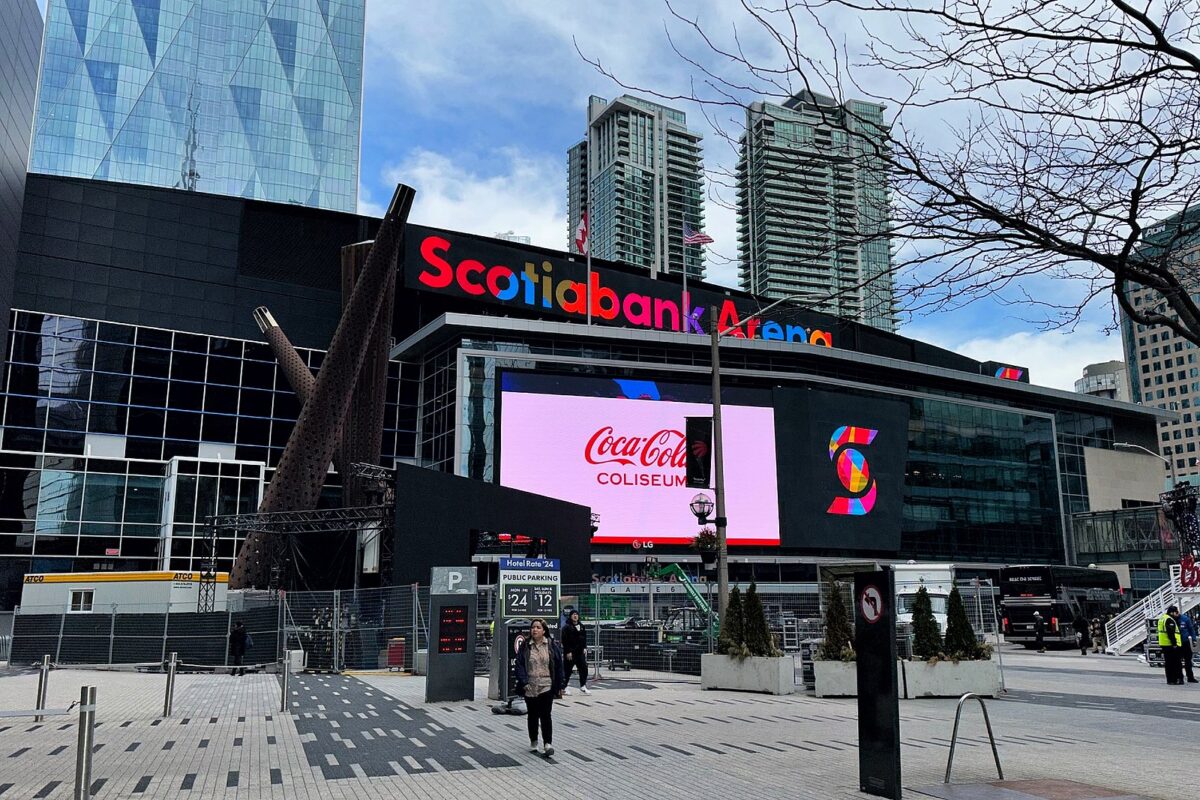There was plenty of blame to go around in the aftermath of the Toronto Maple Leafs’ Game 3 home loss to the Boston Bruins, falling back into a 2-1 hole in the series. The team made some critical mistakes, suffered from possession issues, were dominated on loose pucks and failed to generate enough offence, particularly on the power play.
However, one common gripe coming out of Leafs Nation was the impact (or lack thereof) of the home crowd at Scotiabank Arena. Joe Bowen, the voice of the Leafs, referred to the sellout crowd on hand as “very disappointing.” Breakfast Television, a popular local morning show, even featured a full segment on it.
Now that this has become a hot-button issue in local circles, perhaps the response is as simple as encouraging those attending Saturday’s Game 4 to get to the arena early and get loud, just as Toronto Raptors fans were implored to do by team announcer Jack Armstrong amidst their title-winning 2019 NBA playoff run. However, the long-standing issues of the Maple Leafs’ in-arena experience run far deeper than just one playoff game or series.
The Clientele Won’t Change
Despite Bowen’s complaints, the Game 3 crowd still ranked as the loudest of the season. They cheered as Auston Matthews left the ice last at the end of warm-ups. They roared as the team came out onto the ice ahead of puck-drop. They exploded when Matthew Knies opened up the scoring in the second period and when Ryan Reaves landed a series of bruising hits in the third. When the dust settled, however, most fans were back to sitting and observing quietly.
As anyone who has watched a Maple Leafs game can attest, this is the norm and will continue to be so for as long as Maple Leafs Sports & Entertainment cater to its wealthiest clientele. From the luxury suites to the platinum seats that stay empty well into each period and rarely house fans clad in jerseys, it is the richest fans that, for better or worse, primarily dictate the atmosphere on any game night. This is only emphasized in the postseason, as ticket prices skyrocket.
Look around and you’ll see plenty of evidence of the true passion of Maple Leafs fans, from TV ratings to Maple Leafs Square to the prevalence of supporters in other teams’ rinks. While those signs are less visible in SBA, they were still present on Wednesday night – just not as consistently as they probably should be.
The In-Game Experience Still Needs Work
Hand-wringing over the Maple Leafs’ in-arena experience seems to grow and dissipate at various times, but it has never been truly improved. Sure, Hall & Oates’ “You Make My Dreams” is no more as the official goal song, but the club never settled on a steady option after Kid Cudi’s “Pursuit of Happiness” was scrapped in the face of controversy. Goal song aside, little has been done to shake up the experience save for a few new intermission contests that few bother sticking around for.
On Wednesday, it was more of the same. There weren’t many playoff-specific distinctions apart from a couple cutaways to Maple Leafs Square on the big screen and the presence of rally towels on each chair. The rally towels, a traditional staple of Toronto playoff home games, have always been problematic. For as great a visual as you get from watching nearly 20,000 fans wave their towels in unison, they fundamentally inhibit fans’ abilities to clap and make noise.
No, you shouldn’t need to be prompted to get loud come playoff time, but it’s also true that the in-game experience has never done enough to inspire noise and enhance the atmosphere.
You Might Also Like
- Maple Leafs Should Keep Murray as Third Goaltender
- Flames & Maple Leafs Trade History Revisited
- 3 Players the Maple Leafs Could Target on a PTO
- NHL Rumors: Oilers, Maple Leafs, Capitals, Kuznetsov News
- Maple Leafs Should Target Evgeny Kuznetsov as Reclamation Project
Leafs Fans Don’t Have Much to Cheer For
Let’s face it – the fans in attendance for Game 3 simply weren’t given much reason to cheer through much of the game. Knies got the home side on the board first, but the Bruins recorded the next two goals and limited scoring chances the other way. When Tyler Bertuzzi finally tied things up halfway through the third, it was a mere 28 seconds before Brad Marchand put Boston ahead once again (and for good).
This isn’t to excuse a fan base who gets to enjoy seeing their team reach the postseason each year on the back of the greatest goal scorer in the modern era. But the quiet that engulfed the arena on Wednesday was less rooted in apathy and more tied to the type of anxious desperation that is borne out of a 57-year Stanley Cup wait, annual postseason struggles and an all-too-familiar opponent. And even in the face of those obstacles, those in attendance were ready to erupt during Game 3 but were never totally afforded that opportunity.

For the time being, this ‘Scotiabank Arena is too quiet’ talking point will probably be washed away at the drop of the next William Nylander health update and certainly if Game 4 produces a Toronto victory. It will, however, continue to be a reality for the Maple Leafs, who are 3-8 at home in the playoffs over the past three years. While identifying the issue might be easy, finding solutions is another matter entirely.
